Young People and E-Cigarettes in Scotland: A Survey of Secondary School Pupils
Reports on the findings of a survey in late 2014 with Scottish secondary pupils about e-cigarettes.
Survey Results
Sample
Respondents were asked for their age, gender, ethnicity, and school year. They were also asked for their postcode which was used to assign their home area to a quintile in the Scottish Index of Multiple Deprivation (SIMD). The data were weighted to be representative of Gender, School Year, Ethnicity, Rural/Urban classification and SIMD.
Table 1: Demographic profile of sample
| Demographics | Unweighted (n) | Weighted (n) | Percentage (weighted) |
|
|---|---|---|---|---|
| Gender | Female | 998 | 987 | 50% |
| Male | 988 | 999 | 49% | |
| School Year | S1 | 396 | 352 | 17% |
| S2 | 407 | 355 | 18% | |
| S3 | 258 | 361 | 18% | |
| S4 | 573 | 374 | 19% | |
| S5 | 173 | 332 | 16% | |
| S6 | 209 | 241 | 12% | |
| Age | 11 | 100 | 95 | 5% |
| 12 | 364 | 325 | 16% | |
| 13 | 378 | 346 | 17% | |
| 14 | 355 | 393 | 19% | |
| 15 | 458 | 354 | 18% | |
| 16 | 193 | 306 | 15% | |
| 17 | 153 | 182 | 9% | |
| 18 | 3 | 3 | * | |
| 17/18 | 156 | 185 | 9% | |
| Not stated | - | - | 1% | |
| Ethnicity | White | 1842 | 1847 | 92% |
| Non-white | 153 | 146 | 8% | |
| SIMD | 1 (most deprived) | 160 | 404 | 20% |
| 2 | 418 | 384 | 19% | |
| 3 | 439 | 383 | 19% | |
| 4 | 469 | 421 | 21% | |
| 5 (least deprived) | 530 | 423 | 21% |
Base: 2,016
It was decided to analyse the results by school year group rather than by age as the former may have more of a bearing on the composition of a pupil's peer group and on the health education they would have received in school.
Smoking status
Pupils were asked about their use of conventional tobacco cigarettes towards the end of the survey and after the questions on e-cigarettes to minimise possible confusion for respondents when answering questions intended to be only about e-cigarettes. Figure 1 summarises smoking categories captured by the YPIS.
Figure 1: Smoking status (%).
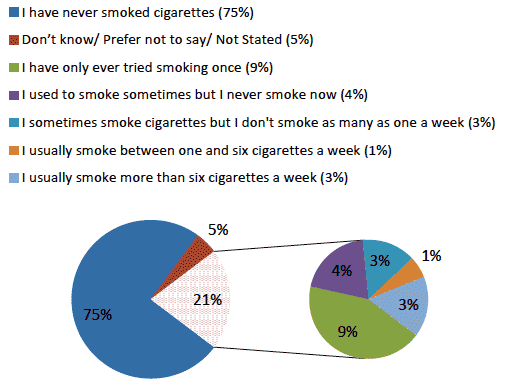
Base (all respondents): 2,016.
Figure 2 shows how ever smoked status varies across the school years.
Figure 2: Smoking status and school year (%).
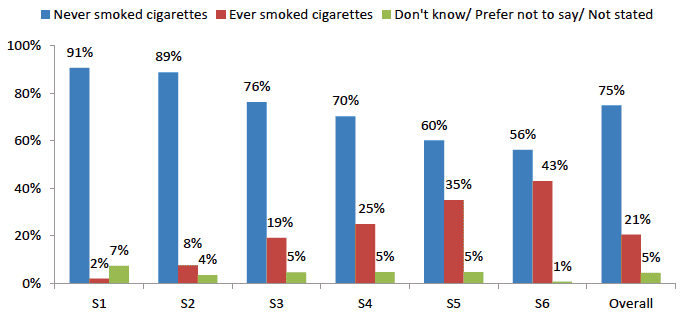
Base (all pupils): 2,016.
General awareness of e-cigarettes
As e-cigarettes have only been widely accessible for a few years, many surveys have included a basic question to gauge general awareness of the products amongst adults and adolescents. Surveys with adults in the UK show near-universal awareness of e-cigarettes: ASH (Action on Smoking and Health) (ASH 2015a) reported that 95% of smokers and 93% of non-smokers had heard of e-cigarettes in 2015. In surveys of young people across the UK, ASH found that in 2013, two thirds of 11-18 year olds and 83% of 16-18 year olds had heard of electronic cigarettes; by March 2014, this had risen to 84% of 11-18 year olds and 90% of 16-18 year olds (ASH 2015b). A survey of 11-15 year olds in England in 2014 found that 88% were aware of e-cigarettes (Health and Social Care Information Centre 2015). This high level of awareness is unsurprising given the visibility of e-cigarette use in everyday environments, their availability in a wide range of sales outlets, marketing which uses an array of channels, the popularity of stories about e-cigarettes in the media, and their use and endorsement by celebrities.
The first question in the YPIS, after those asking for basic demographic data, was used to establish existing awareness of e-cigarettes amongst the pupils. Respondents were asked whether they had heard of e-cigarettes prior to reading the following description:
"When people smoke e-cigarettes, they inhale a vapour that looks like smoke but, unlike normal cigarettes, you don't light them with a flame and they don't burn tobacco. E-cigarettes come in different styles: some look like normal cigarettes and have a glowing tip, while some look more like pens. E-cigarettes are also sometimes known as electronic cigarettes, e-cigs or e-shisha sticks/hookah pens. Using e-cigarettes is sometime called 'vaping'."
Of those who responded to this question, 90% had previously heard of e-cigarettes, which provided a base of 1,777 pupils for subsequent questions about e-cigarettes. Those who had not heard of e-cigarettes were routed away from the questions about e-cigarettes to the questions on tobacco smoking. Slightly more females (91%) than males (89%) had previously heard of e-cigarettes and, unsurprisingly, awareness increased with school year (Figure 3).
Figure 3: Prior awareness of e-cigarettes by school year (%).
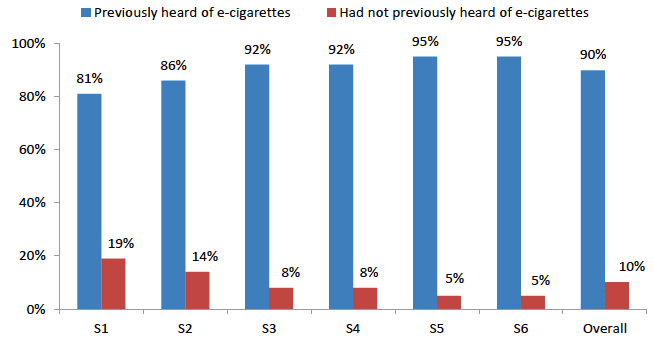
Base (all pupils): 2,016
Pupils who had heard of e-cigarettes were asked a series of questions about their exposure to e-cigarettes in terms of where they had seen them being used, people they know who use them, recent exposure to marketing and promotion, about their own use or experimentation, and their knowledge and attitudes.
E-cigarette use by respondents
Pupils were asked about their own e-cigarette use: "Have you ever used e-cigarettes? Please tick one box only."
Figure 4: E-cigarette use (%).
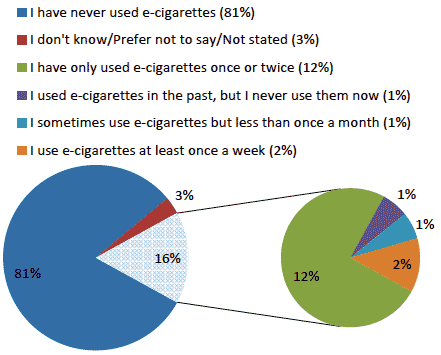
Base (pupils who had heard of e-cigarettes): 1,777
In this report "current use" is defined on the basis of the pupil choosing one of the following responses:
- I sometimes use e-cigarettes but less than once a month
- I use e-cigarettes at least once a month, but less than once a week
- I use e-cigarettes at least once a week
However, it is important to acknowledge that use which is less often than monthly represents a range of possible behaviours, from the early stage of a developing habitual use to experimentation. "Previous use" is defined on the basis of the pupil choosing one of the following options:
- I have only tried using e-cigarettes once or twice
- I used e-cigarettes in the past, but I never use them now.
These two options also represent a range of behaviours from a one-off trial to possibly previous habitual use.
Figure 4 shows that 81% had never used them and most of those who had ever tried had only done so once or twice; 3% were using them "currently"; and 13% had previously used them. Eight-two per cent of the 265 who had ever used them had only ever used them once or twice (n=216).
The 2013 wave of SALSUS collected data on electronic cigarettes use amongst 13 and 15 year olds in Scotland for the first time with a sample of 33,685 pupils in S2 and S4 (ISD 2014). SALSUS found that 88% of 13 and 15 year olds had never used an e-cigarette. Figure 5 compares the rates of ever use for matching ages/school years in the YPIS, SALSUS and a 2014 survey of over 6,000 11-15 year olds in England (Health and Social Care Information Centre 2015). This shows that the YPIS recorded higher rates of having ever used e-cigarettes than SALSUS in 2013 but lower rates than the HSCIC survey in 2014.
Figure 5: Ever use: comparison of YPIS, SALSUS and HSCIC.
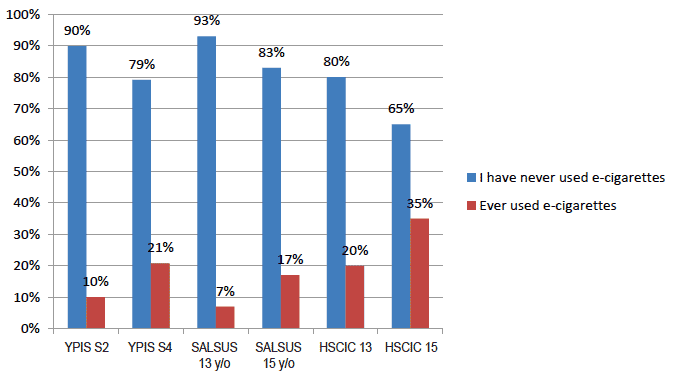
The YPIS 2% rate of regular use of e-cigarettes (net "at least once a month but less than once a week" and "at least once a week") was consistent with the 2% who reported using them monthly or weekly in the ASH 2014 survey (ASH 2015b) and the 2% who use them regularly in the 2015 HSIC survey. Regular use was under 0% of the total SALSUS sample.
Females in the YPIS were more likely to have never used e-cigarettes than males (83% versus 81% respectively); 18% of males had ever used an e-cigarette compared to 16% of females; and 3% of males reported using e-cigarettes at least once a week compared to 1% of females. SALSUS found that 13 year olds boys were more likely to have tried e-cigarettes, but at 15 years there was no difference by gender (ISD 2014). HSCIC (2015) found that 23% of boys and 20% of girls had ever used e-cigarettes.
There was an association between school year and e-cigarette use: rates of ever use increased through each year between S1 (4%) and S5 (29%), although it dropped for S6 (20%). The highest rates of at least weekly use were 4% by S4 pupils and 3% by S3 pupils. The numbers are too small for detailed analysis of use categories by other demographic characteristics.
Figure 6: Use of e-cigarettes by school year (%)
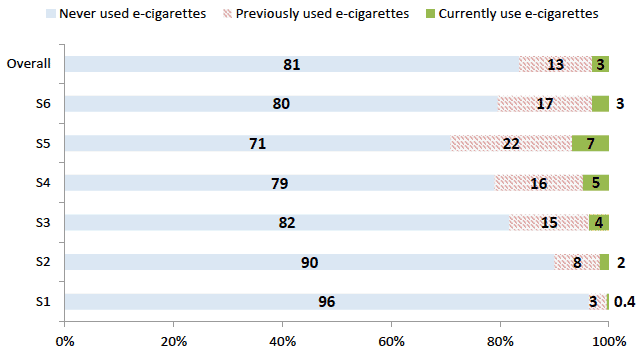
Base (pupils who have heard of e-cigarettes) = 1,777.
Tobacco smoking and e-cigarette usage
Two of the main concerns about use of e-cigarettes by children and young people is that they may serve as a gateway into tobacco use and that their widespread use may undermine and hamper continued efforts to de-normalise smoking. The survey asked pupils which they had used first, tobacco or e-cigarettes and the analysis compared smoking status with e-cigarette use status, alongside questions about attitudes to smoking and e-cigarette use. The limits of what the data can reveal about links between tobacco and e-cigarette use must be understood: a one-off cross-sectional survey of this kind provides a snapshot of reported experience for a sample of young people who are going through a period in their lives of considerable developmental and social change and adaptation. The data can suggest a patterning of associated behaviours but cannot confirm or disprove whether there is a risk of a gateway effect materializing or that there is any causative relationship between the two behaviours.
Figure 7: Use of e-cigarettes by smoking status (%).
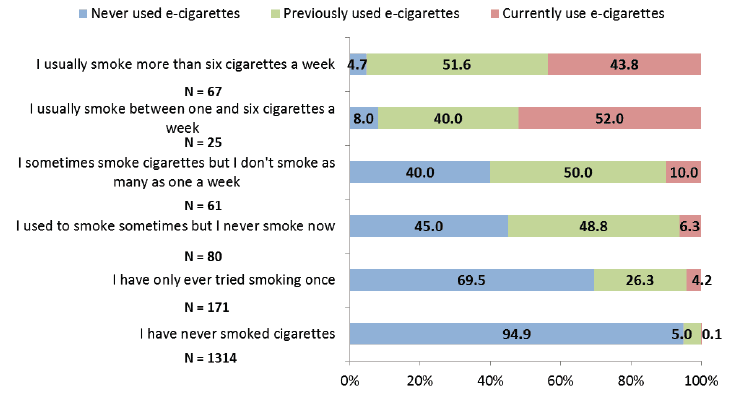
Base (pupils who have heard of e-cigarettes) = 1,777
In common with other surveys of young people in the UK (Bauld et al 2015), the YPIS found an association between smoking tobacco cigarettes and using e-cigarettes. Figure 7 shows, for example, that 95% of those who had never smoked cigarettes had also never tried e-cigarettes compared to 4.7% of those who smoke more than six cigarettes a week. Ever use was associated with increasing use of tobacco. Current use of e-cigarette rose with more frequent tobacco use, apart from a fall with the heaviest smokers (more than six cigarettes a week), although the numbers were small.
SALSUS, which has a much larger sample then the YPIS, found that:
- as noted above, regular use across the sample, was less than 0%
- pupils who had tried smoking, used to smoke or are current smokers were more likely to have tried an e-cigarette;
- 6% of regular and 2% of occasional smokers used e-cigarettes weekly.
- 11% of regular and 6% of occasional smokers used e-cigarettes at least monthly.
- 17% of 15 year olds and 7% of 13 year olds had ever tried or used an e-cigarette.
- 4% who had never smoked had ever used electronic cigarettes.
- 24% of those who have tried smoking had ever used electronic cigarettes.
- 39% of former smokers had used them (19% once, 14% a few times, 3% used to use them and 2% were using them once a month or more).
- 66% of regular smokers and 46% of occasional smokers had used e-cigarettes, however most had only tried them once or a few times (48% of regular and 38% of occasional smokers).
The YPIS and SALSUS findings are broadly similar to those from other UK surveys with young people. ASH (2015b) surveys with young people in March 2013 and March 2014 found that frequent use (more than weekly) was confined almost entirely to ex-smokers and daily smokers and sustained use was rare and confined to children who currently or have previously smoked. The HSCICsurvey in England also found that pupils that have tried smoking were more likely to have also tried e-cigarettes.
The 366 pupils in the YPIS who had ever smoked tobacco were asked whether they had tried tobacco or an e-cigarette first. Twenty-eight per cent had only ever tried tobacco and 16 per cent did not remember or know which was first, preferred not to say or provided no response. Five per cent (N=19) of all those who had ever smoked tobacco had tried an e-cigarette first which equates to 8% of the 235 pupils who had both ever smoked tobacco and ever used an e-cigarette. The numbers are too small to allow for further analysis and, as stated above, a cross-sectional survey cannot indicate a causal link between two activities such as the use of tobacco and the use of e-cigarettes.
Source of first e-cigarette
Pupils who had ever tried an e-cigarette (n=265) were asked where they had obtained it, being asked to select all the response options that applied to them. For the majority (87%) the source of their first e-cigarette was someone they knew, dominated by a friend or someone they were hanging out with (61%) and almost a fifth were given or took the e-cigarette from a family member, and 5% had tried someone's e-cigarette without permission.
Figure 8: Source of first e-cigarette.
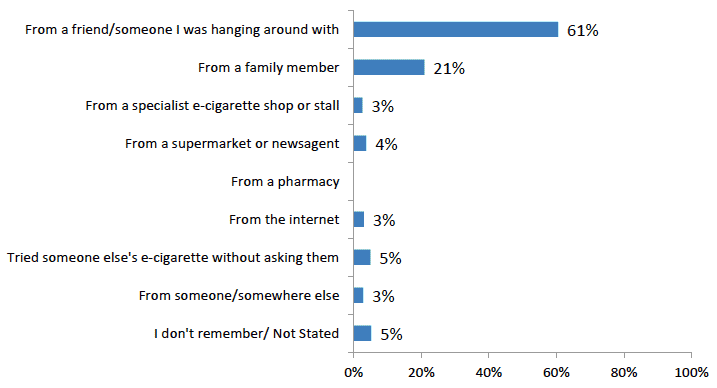
Base (pupils who had ever used e-cigarettes): 265
Ten per cent indicated that it had come from a retail outlet or internet but this may include some who also reported that the e-cigarette belonged to, or was given to them by, someone else because they were allowed multiple options. While the sale of e-cigarettes to under-18s is currently legal, representatives of the e-cigarette sector say that responsible members observes a voluntary restriction not to sell to minors and many products carry an age warning. However, there is evidence, in addition to survey findings on use, that under-18s are able to buy e-cigarettes despite the good practice aspirations in the sector (Trading Standards Institute 2014; Hughes et al 2014).
Reasons for use
Surveys show that adult e-cigarette users are primarily smokers or former smokers who initiated use to help them stop or reduce their tobacco use. However, reasons for experimentation and continued use are likely to be different for young people amongst whom levels of cigarette use are lower. Pupils who had ever used e-cigarettes were asked what had motivated their first use.
Table 2: Reasons for first use
| Thinking about the first time you ever tried an e-cigarette, which of the following best describes your reason(s) for doing so? Please tick all that apply. |
% |
|---|---|
| I just wanted to try them to see what they were like | 42 |
| I saw a friend use an e-cigarette, so I wanted to try them | 27 |
| I saw a family member using an e-cigarette, so I wanted to try them | 19 |
| I wanted to stop smoking normal cigarettes | 10 |
| I wanted to reduce the number of normal cigarettes I smoke | 9 |
| I saw e-cigarettes displayed for sale (e.g. in a shop, at a stall in a shopping centre, in the street or at a market), so I wanted to try them |
2 |
| I saw an advert for e-cigarettes (e.g. online, on social media, on TV, on a billboard), so I wanted to try them |
1 |
| Other reason | 3 |
| I can't remember/ I don't know/ Not stated | 9 |
Base (pupils who had ever used e-cigarettes): 265
What seems clear from these results is that curiosity, impulsivity and a wish to experiment are the main drivers for youth use, in some cases prompted by use by peers and kin.
The small number (30) of pupils who reported that they use e-cigarettes at least once a week were asked "Why do you currently use e-cigarettes? Please give the MAIN reason only." Due to the small numbers involved, the following results should be interpreted with caution:
- 17 respondents reported that they use e-cigarettes as a substitute for normal cigarettes, with 11 reporting that they use them to "reduce the number of normal cigarettes I smoke" and 6 using them "to help me stop smoking normal cigarettes altogether".
- 9 respondents use e-cigarettes simply "because I enjoy it".
- 3 respondents currently used e-cigarettes "to try it out";
- 3 respondents listed their reason as "other".
- No respondents reported using them because "I feel pressure to fit in with everyone else who is using them", ""just because my friends use them", "I can't stop using them/I am addicted to them", or "using them is a new trend and I want to be part of it".
It is not possible to draw generalisations for adolescent motivation for regular e-cigarette use from a sample of this size; this is an area where further research is needed.
Exposure to e-cigarette use by others
To understand the ways in which young people are exposed to e-cigarettes, the survey asked a number of questions about use by people they knew and the situations where they had seen e-cigarettes being used.
E-cigarette use by family and friends
Pupils who had heard of e-cigarettes were asked: "How many of your family use e-cigarettes? When we say family, we mean the close family that you live with (even if you only live with them for some of the time). (Please tick one box only)"
Table 3: Use by family members (%)
| Use by family | % |
|---|---|
| All or almost all | 1 |
| More than half | 1 |
| Half | 2 |
| Less than half | 5 |
| Hardly any | 19 |
| None | 66 |
| I don't know | 7 |
Base (pupils who have heard of e-cigarettes) = 1,777
Pupils were asked: "How many of your friends use e-cigarettes? Please tick one box only."
Table 4: Use by friends (%)
| Friends' use | % |
|---|---|
| All or almost all | 1 |
| More than half | 1 |
| Half | 1 |
| Less than half | 6 |
| Hardly any | 21 |
| None | 50 |
| I don't know/not stated | 22 |
Base (pupils who have heard of e-cigarettes) = 1,777
Over two-thirds (71%) stated that none/hardly any of their friends use e-cigarettes and more females (57%) than males (45%) reported that none of their friends use e-cigarettes. In total, 0.5% of respondents reported that all or almost all of their friends use e-cigarettes. There were some differences in friends' use by school year, most notably differences in S1 and S2 compared to other years: 66% of S1 pupils report that none of their friends use e-cigarettes compared to 40% of S3 pupils; 9% of S1 pupils report that (at least) some of their friends use e-cigarettes compared to 37% of S3 pupils.
Table 5: Use by friends by school year (%)
| Use by friends | All or almost all | More than half | Half | Less than half | Hardly any | None | I don't know | Not stated |
|---|---|---|---|---|---|---|---|---|
| S1 | 0 | 0 | 0 | 3 | 5 | 66 | 20 | 5 |
| S2 | 0 | 1 | 1 | 4 | 17 | 52 | 22 | 3 |
| S3 | 1 | 0 | 1 | 5 | 30 | 40 | 22 | 1 |
| S4 | 2 | 2 | 2 | 9 | 20 | 45 | 19 | 2 |
| S5 | 0 | 0 | 1 | 10 | 25 | 41 | 22 | 0 |
| S6 | 0 | 0 | 1 | 3 | 26 | 58 | 11 | 1 |
Base (pupils who have heard of e-cigarettes) = 1,777
Contexts for e-cigarette exposure
Respondents were asked to select situations and environments in which they had recently seen someone use an e-cigarette:
"Thinking about the last 4 weeks, have you seen anyone use e-cigarettes in the following locations? Please tick the box next to every place where you have seen this."
Figure 9: Where e-cigarettes use had been seen in past 4 weeks
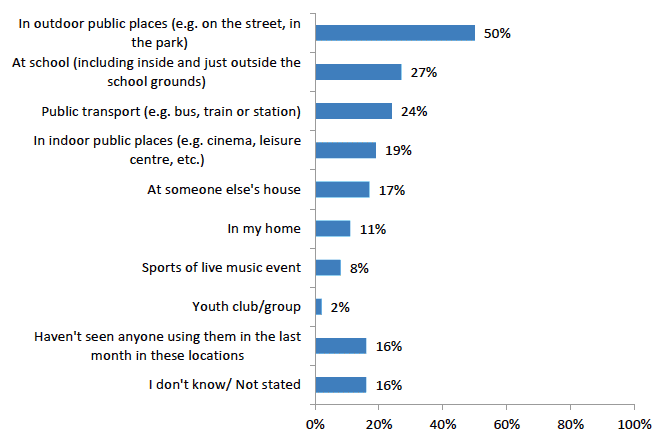
Base (pupils who had heard of e-cigarettes): 1,777
Unsurprisingly, pupils had seen e-cigarettes in a wide range of environments, although 16% had not seen them being used and the same proportion said they did not know or did not respond to the question. Half of pupils had seen them in use in an outdoor public place (e.g. in the street, in a park) and more than a quarter had seen them being used in or around their school.
Exposure to the marketing of e-cigarettes
As noted above, the Scottish Government recognises that e-cigarettes may help some smokers to stop or reduce their tobacco use, but does not believe that e-cigarettes are suitable for use by under-18s and is concerned about their exposure to the marketing of such products. A number of studies in the UK and USA (de Andrade et al 2013a, 2013b; Grana 2014; Legacy 2014) have analysed the content of e-cigarettes marketing and concluded that some of the ways in which they are promoted appear to be targeted at young adults and would be appealing to adolescents and even children. However, there had been little research with young people on their interaction with e-cigarette marketing until 2014.[13] There was a need in Scotland to establish, from young people themselves, the extent to which they are aware of e-cigarette marketing in its different forms.
Respondents were asked:
"Have you seen any of the following in the last 7 days?"
Figure 10: Exposure to e-cigarette marketing and images in past seven days (%).
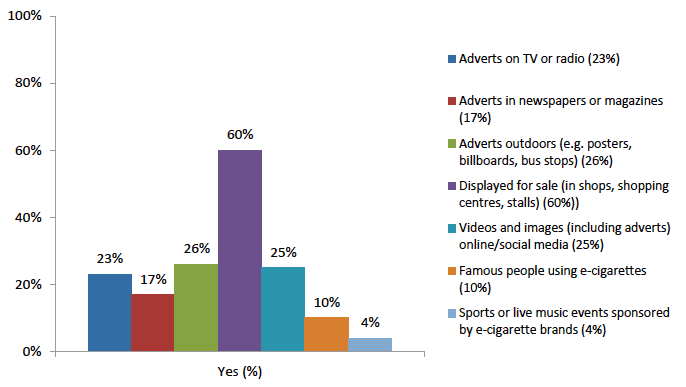
Base (all pupils who had heard of e-cigarettes): 1,777
The YPIS survey shows that secondary school pupils in Scotland are being exposed to e-cigarettes promotional material in a wide range of marketing contexts. Figure 10 illustrates that in the past week, a majority (60%) had seen e-cigarettes displayed for sale in shops, shopping centres and stalls. Around a quarter of respondents had been exposed to e-cigarette adverts in each of the following contexts: outdoors on posters, billboards or bus stops; on TV or radio; and in videos and online images. Around 4% of respondents reported seeing sports or live music events sponsored by e-cigarette companies and a tenth had seen celebrities using e-cigarettes.
Knowledge and attitudes about smoking and e-cigarettes
It is important to find out how much young people know about e-cigarettes so pupils were given four knowledge statements.
"Please read the following statements about e-cigarettes and say if you think they are true or false. Please tick one box only for each row."
Table 6: Responses to knowledge statements on e-cigarettes (%)
| True | False | Don't Know | Not Stated | |
|---|---|---|---|---|
| E-cigarettes can contain nicotine | 65% | 10% | 24% | 1% |
| E-cigarettes are addictive | 54% | 15% | 30% | 2% |
| E-cigarettes are not harmful to health | 17% | 51% | 30% | 2% |
| E-cigarettes are less harmful to health than normal cigarettes | 69% | 7% | 22% | 2% |
Base (respondents who have heard of e-cigarettes): 1777.
Given public uncertainty around the immediate and long-term safety of e-cigarettes and their relative risk compared to tobacco, it is perhaps unsurprising that a fairly high proportion of respondents chose 'don't know' for each of the statements.
Two-thirds knew that they could contain nicotine. Nearly 70% correctly thought that they are less harmful than normal cigarettes and just 7% did not, and 22% did not know. The ASH 2014 survey found that 11-18 year olds believed that they are less harmful than tobacco cigarettes to the user (74%) and to those around them (79%) (ASH 2015b).
The other two statements are more ambiguous, with no 'right' answer, and the pupils' responses reflect that. There is insufficient evidence to say with complete certainty that e-cigarettes are not harmful to health in any way and the results suggest that pupils appreciate that they are not as risky as tobacco but cannot be said to be risk-free. Thirty per cent did not know whether the statement was true. Nicotine is a highly addictive substance and most e-cigarettes are used with a liquid which contains nicotine. However, the degree to which the nicotine used in e-liquids and the behavioural factors of vaping may independently and in combination render e-cigarettes more or less addictive than other nicotine products cannot be definitely concluded on the basis of current evidence. More than half of respondents thought that e-cigarettes are addictive, which would in part be based on their knowledge of nicotine, but again 30% did not know how to respond.
Interestingly, surveys with adults show contrasting results on the question of perceived relative risk. ASH found that between 2013 and 2015 the proportion who wrongly think e-cigarettes are as harmful as tobacco increased from 6% to 20% balanced against an increase in the number who think electronic cigarettes are less harmful from 43% in 2013 to 52% in 2015 and a decrease in the number of people who do not know whether an e-cigarette is more or less harmful than a regular cigarette (38% in 2013 to 23% in 2015) (ASH 2015a).
Pupils were also given three attitudinal statements, one on smoking tobacco and two about e-cigarettes:
"Please read the following statements about e-cigarettes and normal cigarettes and say how much you agree or disagree with each one. Please tick one box only for each row."
Table 7: Attitudes to tobacco and to e-cigarettes.
| Strongly agree | Tend to agree | Neither agree nor disagree | Tend to disagree | Strongly disagree | I don't know | Not stated | |
|---|---|---|---|---|---|---|---|
| Smoking normal cigarettes is cool | 1% | 1% | 7% | 9% | 78% | 3% | 1% |
| Using e-cigarettes is fun | 1% | 3% | 12% | 10% | 54% | 18% | 2% |
| E-cigarette adverts make using them look cool | 3% | 8% | 11% | 11% | 50% | 16% | 2% |
Base: (respondents who have heard of e-cigarettes): 1777.
A clear majority did not think smoking conventional cigarettes is 'cool' (87% net 'tend to disagree/strongly disagree') and only 3% thought smoking is cool. In contrast, although 64% of pupils disagreed that using e-cigarettes is 'fun', they seemed less certain about how they felt about using e-cigarettes, with almost a fifth (18%) choosing 'don't know' and another 12% neither agreeing or disagreeing. A majority (61%) also did not think that e-cigarettes adverts make them look 'cool' and again there was a degree of uncertainty, although 11% agreed with the statement.
Over time it will be important to monitor young people's changing knowledge, understanding and attitudes towards e-cigarettes and towards smoking tobacco to see to what extent e-cigarettes become an acceptable, normalised recreational product and whether attitudes to tobacco smoking change which might provide an indication of whether a re-normalisation or an increased social acceptability of smoking are occurring.
Contact
Email: Fiona Macdonald
There is a problem
Thanks for your feedback